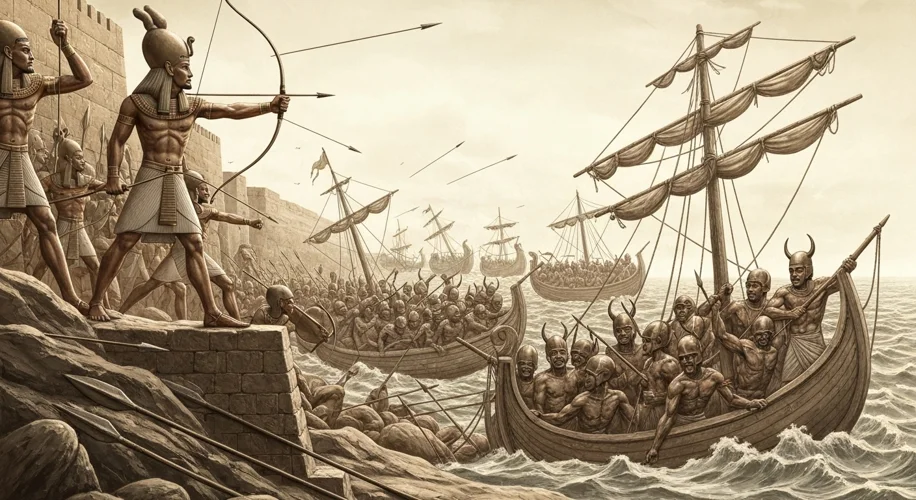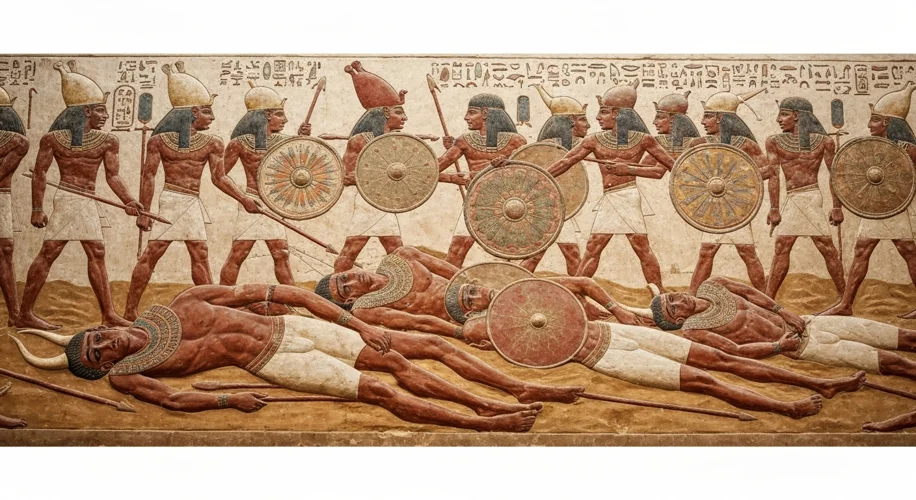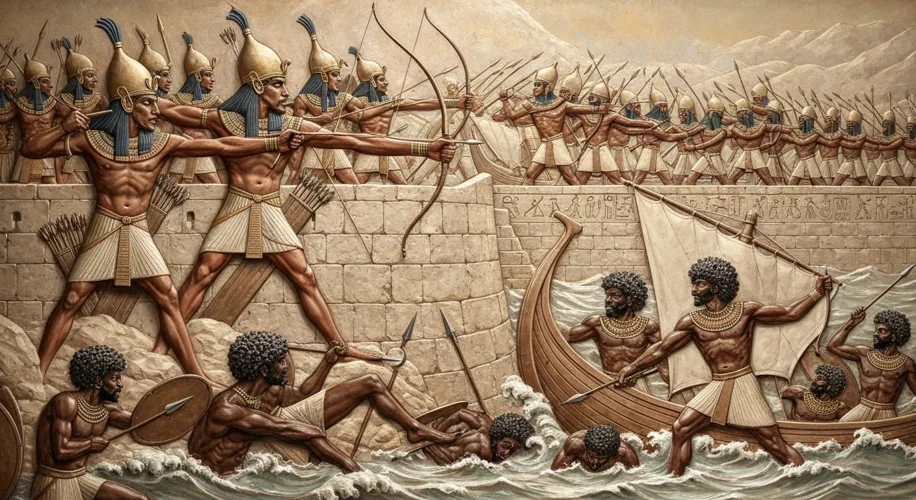The year is 1178 BCE. Along the fertile banks of the Nile, the mighty Egyptian empire stands as a beacon of civilization, its temples reaching towards the heavens, its pharaohs commanding unparalleled power. Yet, a storm was gathering on the horizon, a tempest of bronze and iron poised to engulf the Eastern Mediterranean. This was the era of the Sea Peoples, a mysterious confederation of warriors whose arrival would mark the violent twilight of the Late Bronze Age.
At the heart of this cataclysmic conflict stood Ramesses III, the last of the great warrior pharaohs of Egypt. His reign, though a dazzling final flourish, was defined by the existential threat posed by these enigmatic invaders. For years, tales of their devastating raids had rippled through the ancient world, leaving a trail of sacked cities and terrified populations in their wake. They were not a single nation, but a motley collection of peoples – the Peleset (often linked to the Philistines), the Denyen, the Shekelesh, the Sherden, and others – sailing in their distinctive ships, their war cries echoing across the waves.

The epic struggle between Ramesses III and the Sea Peoples is immortalized not just in papyrus scrolls, but in the colossal stone reliefs that adorn the mortuary temple of Ramesses III at Medinet Habu. These aren’t mere decorations; they are a visual chronicle, a triumphant testament carved in granite, meant to awe and inspire generations.
The reliefs at Medinet Habu paint a vivid, if biased, picture of the conflict. They depict the Pharaoh, a towering figure of divine strength, personally leading his armies. The scenes are visceral: Egyptian chariots thunder across the battlefield, arrows fly thick in the air, and the bodies of fallen enemies litter the ground. But it is the naval engagement that truly captures the imagination. The Egyptians, masters of riverine warfare, adapted their skills to the sea. Their sturdy galleys, manned by disciplined crews, clashed with the lighter, more agile vessels of the Sea Peoples. The artwork shows the Egyptians grappling with the invaders, hauling them aboard, and dispatching them with brutal efficiency. Bodies of defeated enemies, recognizable by their distinct attire and weaponry, are shown floating in the water, a stark testament to Egyptian victory.
Ramesses III himself is often depicted as a lion, a symbol of strength and ferocity, smiting his foes with a mighty mace. The accompanying hieroglyphic texts provide a narrative, glorifying the Pharaoh’s divine might and the salvation of Egypt. They speak of a decisive naval battle fought off the coast of the Delta, where the Egyptian navy, strategically positioned, annihilated the enemy fleet. Land battles are also depicted, with Ramesses III leading his infantry against the invaders who had landed on Egyptian soil.
The victory at Medinet Habu, however, was not the end of the story for the ancient world. While Ramesses III repelled the Sea Peoples, the empire itself was left weakened, economically and politically. The immense cost of prolonged warfare, coupled with internal strife and economic instability, began to erode Egypt’s power. The Late Bronze Age, across the wider Near East, was characterized by widespread collapse, with many powerful kingdoms and cities – the Hittites, Ugarit, Mycenaean Greece – falling into ruin or decline. The Sea Peoples are often seen as a catalyst, if not the sole cause, of this broader collapse, their migratory movements disrupting established trade routes and political structures.

The reliefs at Medinet Habu offer a unique window into an ancient world teetering on the brink of transformation. They showcase the sophisticated military strategies of the Egyptians, their prowess in both land and naval combat, and their mastery of propaganda through monumental art. The depiction of the Sea Peoples, while demonizing them from the Egyptian perspective, provides tantalizing clues about their origins and their role in the Bronze Age collapse. Were they refugees fleeing a disaster? Mercenaries seeking new opportunities? The truth is likely a complex amalgam. Their ultimate fate remains shrouded in mystery; some assimilated into local populations, notably in the Levant, giving rise to the Philistines of biblical fame, while others simply disappeared from the historical record.
The legacy of Ramesses III’s war against the Sea Peoples is profound. It represents one of the last great stands of a declining Bronze Age civilization against forces of change that would ultimately reshape the geopolitical landscape of the ancient Near East. The very fact that these events are so vividly preserved on the walls of Medinet Habu ensures that the courage of Ramesses III and the terror of the Sea Peoples continue to echo through the corridors of time, reminding us of the ever-present flux of history and the enduring power of human conflict and resilience.

